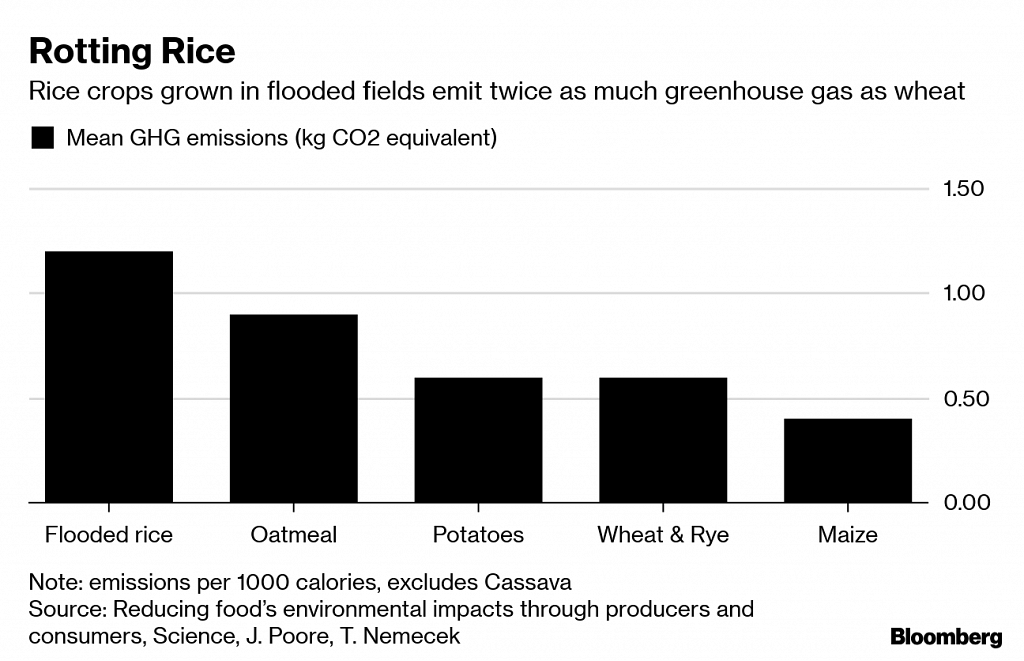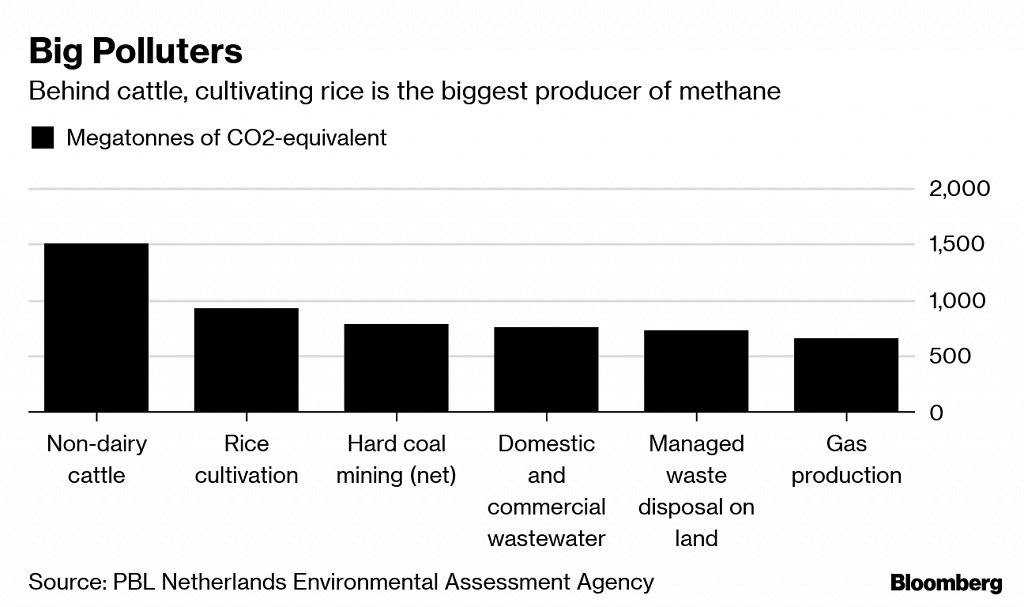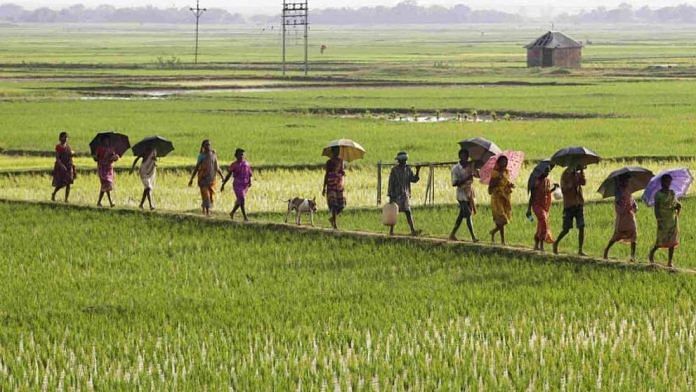London: Eco-conscious consumers are giving up meat and driving electric cars to do their part for the environment, but what about that bowl of rice?
Global rice farming, it turns out, could have the same detrimental effect on global warming in the short term as 1,200 average-sized coal power plants, according to the New York-based Environmental Defense Fund advocacy group. That means the grain is just as damaging over the long term as annual carbon dioxide emissions from fossil fuels in Germany, Italy, Spain and the U.K. combined.
As the sheer size of the staple food’s carbon footprint becomes clearer to scientists, companies including the maker of Uncle Ben’s rice and Olam International Ltd., the world’s second-biggest rice supplier, are starting to source more of the grain from farms that aren’t flooded, a widespread cultivation technique that releases methane gas into the atmosphere.
“The amount of attention that rice receives for these issues is relatively small compared to the size of the problem,” says Paul Nicholson, who heads rice research and sustainability for Olam from Singapore. “People are very informed on their chocolate, coffee, hair care solutions, but rice is an afterthought.”Rice is the staple food of hundreds of millions of Asians and by far the most polluting grain — emitting twice as much of the harmful gases as wheat. Yet it hasn’t been in the spotlight as much as, say, beef, which produces far more emissions per calorie and along with other animal products is the culprit behind almost 60% of greenhouse gas emissions coming from food.
That’s changing as socially conscious consumers, especially in Europe and North America, increasingly demand evidence that the foods they spend their money on are doing the least harm to the environment — and treating farmers and workers in developing countries fairly. With agriculture emitting almost as much greenhouse gas as transportation, those demands will only intensify.
For millennia, rice farmers from Spain to Indonesia have relied on the practice of flooding paddy fields because it stops weeds from growing. But there’s a big drawback: submerging the crop allows tiny underwater microbes to decay organic matter, producing methane, a greenhouse gas that is 25 times more potent than CO2 even though it lingers in the atmosphere for a shorter time. Growing rice in flooded conditions causes up to 12% of global emissions of methane, a gas blamed for about one quarter of global warming caused by humans.
Also read: Climate change helped wipe out these four mighty ancient civilisations
The Sustainable Rice Platform, or SRP, overseen by the United Nations and International Rice Research Institute, is trying to promote change. Earlier this year, the Bangkok-based body released updated guidelines on growing rice more sustainably by, for instance, alternately wetting and drying the crop rather than keeping it flooded, not burning the what’s left of the crop after it has been harvested, using organic fertilizers and promoting fair working conditions.
The SRP is working with thousands of farmers in countries like India, Nigeria, Thailand and Vietnam to give them a score based on these and other factors, with its work funded by corporate members and non-governmental organizations. Rice that complies with the standard will eventually be eligible to carry an “SRP-verified” logo, a certification that will be rolled out later this year—giving consumers a choice for the first time.
Mars Inc., the producer of the Uncle Ben’s brand popular in the U.S. and Europe, shifted to sourcing 87% of its rice under the standard this year, a ratio it expects to boost to 100% by 2020. Olam, too, said it’s pursuing initiatives to get farmers to grow sustainable rice in five Asian and African countries.

“We are working with farmers to develop new methods,” said Louke Koopmans, Mars Food’s global sustainable sourcing manager. As an example, she said the company’s work with 2,500 basmati rice farmers in India and Pakistan has reduced water use by 30%, along with increasing their crop yield and boosting their wages.
“It requires a careful dance of water levels to manage two populations of microbes”
But alternative growing methods carry their own risks.
While farmers can drastically curtail overall emissions if they alternate between wetting and drying, this only works if they flood the crops shallowly. Otherwise as water levels fluctuate, it brings in oxygen which mingles with the nitrogen in the soil and fertilizers to release nitrous oxide, according to K. Kritee, a scientist at the Environmental Defense Fund. Nitrous oxide is 300 times more damaging than CO2 and stays around for more than 100 years longer.
“It requires a careful dance of water levels to manage two populations of microbes,” she said.

To reduce emissions risk from both gases, a study by the EDF in India suggested keeping the water level between 5 centimeters above the surface and 5 cm below. Over a 20-year horizon, total greenhouse gas emissions from rice could take the same toll on the environment as 1,200 coal plants, with the impact dropping to the equivalent of 600 coal plants over 100 years, EDF research shows.
Also read: India must go beyond seeing climate change as a rich vs poor diplomacy battle
While a lot of farmers in countries like Vietnam, Cambodia and Laos are already being encouraged to grow rice on non-flooded fields, part of the challenge is that farmers need to be trained, for instance, in how to use field water tubes to measure moisture levels. Rolling out such methods in India and China, where rice is a daily staple, will be difficult because of the prevalence of small-scale farms where the grain is produced by families for their own consumption. At the moment, it can take more than 1,400 liters of water to produce one kilogram of rice, according to the International Rice Research Institute.
Olam and SRP aim to train 150,000 farmers by 2023 in Asia and Africa. But even that will barely move the needle, accounting for only 0.1% of the households farming rice globally.
One solution for the environment, according to Kritee, would be for consumers to shift to eating more alternative grains — like maize and wheat — that leaves less of a footprint.
But rice consumption is rising in Europe and the U.S. as more people adopt vegetarian and vegan diets. Even so, the the U.S. makes up less than 1% of total consumption, compared with almost 50% in China and India. To meet growing demand in the next 25 years, rice production must increase by 25%, according to the International Rice Research Institute.
“It’s a dilemma how to deal with this because rice is a staple and of deep cultural value for all in Asia,” Kritee said.- Bloomberg



